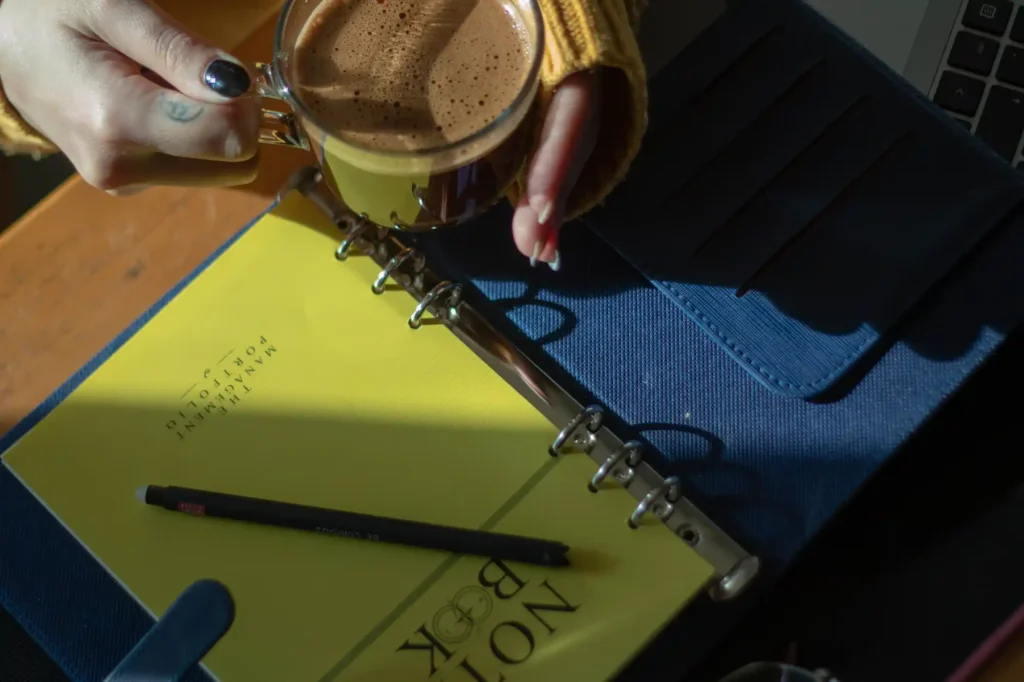I think these are my best productivity hacks: writing a to-do list I can finish, blocking time for deep work, grouping similar tasks, and turning off distractions when I need to focus. I also use the two-minute rule, prep my schedule the night before, and line up tasks with how my energy shifts throughout the day.
I’ve also pulled together some practical tips for staying organized, because in my opinion, you can’t really be productive if you’re not organized. Or maybe you can, but I know I have a hard time doing that.
Why Most People Struggle with Productivity
Let’s be honest – we live in a world designed to destroy our focus. Your phone buzzes every few minutes, emails pile up faster than you can answer them, and that simple task you planned to do in the morning somehow turns into five different things by lunch.
The real problem isn’t that we don’t know what productivity looks like. We’ve all had those magical days where everything flows, we finish our important tasks, and we leave work feeling accomplished. The issue is that we can’t seem to recreate those days consistently.
Most people approach productivity backward. They try to cram more into their day instead of doing fewer things better. They download productivity apps that promise to solve everything but end up spending more time managing the app than doing actual work. They multitask thinking it makes them efficient when research shows it makes them slower and more prone to mistakes.
The result? You’re busy all day but feel like you accomplished nothing meaningful. You work longer hours but get less done. You feel guilty for not being productive enough, which creates stress that makes you even less productive.
What’s Really Blocking Your Productivity
Before jumping into solutions, you need to understand what’s standing in your way. After years of trial and error, I’ve identified the main productivity killers that most of us face:
The Overcomplicated To-Do List Problem
I love the simplicity of to-do lists, but I’ve also been known to overcomplicate them by adding way too much on my plate. When your to-do list has 15 items and you realistically have time for 3, you’re setting yourself up to feel like a failure every day.
The issue isn’t the list itself – it’s that we treat all tasks as equally important and don’t account for how long things take. We also forget that interruptions and unexpected tasks will eat up at least 25% of our planned time.

The Attention Span Crisis
I don’t know about you, but I feel like my attention span is decreasing with each day. And how can I be productive when I get distracted all the time by notifications from Reddit, unwanted emails, or even my random thoughts?
The constant switching between tasks doesn’t just waste time – it exhausts your brain. Every time you shift focus, your mind needs time to fully engage with the new task. This “switching cost” can eat up hours of your day without you realizing it.
Energy Management vs. Time Management
I used to push through when I was tired, thinking that was the right approach. It usually backfired, and I’d get less done and feel worn out by the end of the day. Most productivity advice focuses on managing time, but energy is actually more important.
You can have all the time in the world, but if you’re trying to do creative work when your brain is fried, or handle administrative tasks when you’re at peak energy, you’ll be fighting against your natural rhythms instead of working with them.
The Multitasking Myth
I used to think that the best way to get more done was by multitasking. I’d bounce between emails, messages, and whatever else was on my list, thinking I was being the most efficient person on the planet. But it did the opposite.
Each time I switched tasks, I’d lose focus and have to mentally reset, which slowed everything down. What feels like efficiency is the opposite – you’re doing multiple things poorly instead of one thing well.
My 8 Best Productivity Hacks That Work
Now that you understand what’s working against you, here are the productivity hacks that have made the biggest difference in my daily routine. I’ve organized them into four categories that tackle the main productivity challenges: planning your day, staying focused, managing your energy, and working more efficiently.
The key is building these into habits rather than trying to remember them every day – which is why I’ll show you how to track your progress at the end.

Planning Hacks: Get Your Day Under Control
The foundation of productivity is knowing what you need to do and when you’ll do it. These two hacks help you start each day with clarity instead of chaos.
Productivity Hack #1: Master Your Daily Priorities
I love the simplicity of to-do lists, but I’ve also been known to overcomplicate them by adding way too much on my plate. Here’s how I approach to-do lists now:
Top Three: At the start of each day, I pick the three most important tasks. Add up to 5 top priority tasks if needed, but no more.
Break It Down: If a task feels too big, I break it into smaller, manageable steps.
Cross It Off: Crossing off even one major task gives me a sense of accomplishment and keeps me motivated.
The trick is learning to prioritize key tasks daily and finding simple, easy-to-use systems that don’t become a project themselves.
My Free To-Do List Template helps you apply this hack immediately. It’s designed to keep you focused on what matters most without the overwhelm of endless lists.
Download your free To-Do List template here and start prioritizing like a pro!
Productivity Hack #2: Plan Your Day the Night Before
Even though I am a morning person all the way, I don’t like starting the day without a clue of what needs to be done. Ideally, I take 10 minutes every evening to plan my next day.
My Simple Process:
- Review what didn’t get done today
- Write tomorrow’s top three priorities
- Prep anything you’ll need (like setting out workout clothes or organizing files for a meeting)
Taking those few minutes in the evening makes a big difference in the morning. Waking up with a plan helps me hit the ground running instead of wasting time figuring out what to do first.
Focus Hacks: Protect Your Attention
In our distraction-filled world, your ability to focus deeply is your competitive advantage. These three hacks help you create and maintain the focus you need for your best work.
Productivity Hack #3: Use Time Blocking for Deep Work
I already mentioned that for me, time blocking is a great tool for organization, and I use it in the way it works for me – specifically for blocking and organizing my time after work. But time blocking also makes me more productive.
My Morning Routine Example:
- 06:15 AM – 06:30 AM: Wake up and freshen up
- 06:30 AM – 07:00 AM: Coffee and breakfast
- 07:00 AM – 07:30 AM: Plan the day, set goals
- 07:30 AM – 08:00 AM: Get ready
- 08:00 AM – 08:30 AM: Get to work and start my work day
Keep in mind that this is just a simple routine example of how I set up my mornings when I work my 9-5 job. The key is to batch similar tasks together and schedule breaks in between.
Productivity Hack #4: Eliminate Digital Distractions
I don’t know about you, but I feel like my attention span is decreasing with each day. And how can I be productive when I get distracted all the time by notifications from Reddit, unwanted emails, or even my random thoughts?
Now I try to use these strategies to stay focused:
Turn Off Notifications: My phone stays on “Do Not Disturb” during work sessions.
Set Boundaries: I let people know when I’m heads-down and not available to chat. It’s especially helpful when working from home, where the lines can get blurry.
Use Focus Time: Your mobile phone probably has this option – mark the applications that distract you the most (Instagram, TikTok) and “lock” them while you’re in focus mode.
Productivity Hack #5: Stop Multitasking, Start Single-Tasking
I used to think that the best way to get more done was by multitasking. I’d bounce between emails, messages, and whatever else was on my list, thinking I was being the most efficient person on the planet. But it did the opposite.
Each time I switched tasks, I’d lose focus and have to mentally reset, which slowed everything down. Now I stick to one thing at a time whenever I can. It’s less stressful, and I finish stuff instead of half-starting a dozen things.
Here’s how I make it work:
Set a Timer: I like to use the Pomodoro Technique (25 minutes of work, 5-minute break) to stay focused. Sometimes it works, other times I can’t do it for 25 minutes, but that’s also fine.
Clear My Space: I remove anything unrelated to the task at hand.
Stay Present: If I catch my mind wandering, I gently bring it back to the task.
Energy Hacks: Work With Your Natural Rhythms
Productivity isn’t just about time management – it’s about energy management. These hacks help you work with your body’s natural patterns instead of against them.
Productivity Hack #6: Match Tasks to Your Energy Levels
I’ve learned that productivity has a lot to do with energy, not just time. I used to push through when I was tired, thinking that was the right approach. It usually backfired, and I’d get less done and feel worn out by the end of the day.
Now I try to match tasks to my energy levels instead, which makes the whole day run smoother.
I focus on these energy-boosting habits:
| Habit | When I use it | When I don’t |
|---|---|---|
| Staying Hydrated | I feel clearer, more alert, fewer headaches | Foggy, sluggish, always reaching for coffee |
| Moving Often | Recharged, less tense, better focus | Stiff, tired, hard to concentrate |
| Eating Smart | Steady energy, no crashes, more productive | Cranky, distracted, major afternoon slump |
Please don’t let anyone tell you that taking care of yourself is lazy, un-productive or a waste of time.
Efficiency Hacks: Work Smarter, Not Harder
These final two hacks help you get more done in less time by working with how your brain naturally processes tasks.
Productivity Hack #7: Batch Similar Tasks Together
I’ve started batching similar tasks together because if you constantly switch between tasks, you’re just losing time and energy.
For example, here’s how I batch similar tasks:
Emails: I check and respond to emails only twice a day – in the morning and before wrapping up work.
Errands: If I need to run errands, I plan to do them all at once instead of spreading them out over the week, if possible.
Creative Work: Writing, brainstorming, or designing all happens during one dedicated time block.
This keeps me in the right mindset for each type of task, saving time and energy.
Productivity Hack #8: Apply the Two-Minute Rule
My version of procrastination is usually doom scrolling Instagram or reading blogs with yummy recipes. But when I’m procrastinating, it’s usually because a task feels too big or overwhelming.
The Two-Minute Rule was introduced by David Allen in his book Getting Things Done. The concept is straightforward: if a task takes less than two minutes to complete, do it immediately. It’s designed to prevent small tasks from piling up and taking more time later.
If something can be done in two minutes or less – like replying to an email, tidying my desk, or scheduling an appointment – I do it right away. For bigger tasks, I’ll spend just two minutes starting them. Usually, that’s enough momentum to get going.
By focusing on one thing at a time, I’ve noticed my work is not only faster but also better.
Track Your Progress with My Free Habit Tracker
The best productivity hacks mean nothing if you don’t build them into consistent habits. That’s why I created a simple habit tracker that helps you turn these strategies into daily routines.
My Free Habit Tracker Template helps you:
- Track up to 2 productivity habits at a time (like morning planning or time blocking sessions)
- See your consistency over a full month with an easy dot-to-fill grid
- Note what’s working and what needs adjustment in the notes sections
- Build momentum by celebrating small wins
Whether you want to track your morning routine, time blocking sessions, weekly reflections, or any other productivity habit from this article, this tracker keeps you accountable without overwhelming you.
The beauty of habit tracking is that it shows you patterns. Maybe you’re more consistent on certain days of the week, or you notice that missing one habit affects others. This insight helps you adjust your approach and build systems that stick.
Download your free Habit Tracker template here and start building productive habits that last!
Reflect and Reset Weekly
Every Sunday, I take 20-30 minutes to reflect on the past week and plan for the next one. This simple habit keeps me on track and helps me adjust when things don’t go as planned. I’m not gonna lie to you and say I do it every week – sometimes I’m hungover, sometimes I spend my whole Sunday out in nature and the only thing I do when I’m back is take a shower and hit the bed.
But when I do reflect, here’s what I review:
Wins: What went well? Challenges: What didn’t work?
Adjustments: How can I improve for next week? How can I improve my productivity?
This weekly check-in prevents you from repeating the same mistakes and helps you notice what’s working so you can do more of it.
Final Thoughts: Productivity Is Personal
Productivity looks different for everyone. The key is finding what works for you and sticking with it. For me, the best productivity hacks are the ones that are simple and realistic – things like time blocking, cutting out distractions, and getting enough sleep. These habits help me stay on track without overcomplicating things.
Start small, keep it steady, and if you have an off day, just pick it back up the next. The goal isn’t perfection; it’s progress. Use my habit tracker to build one or two productivity habits consistently, and you’ll see how small changes compound into bigger results over time.
FAQ
Here are some of the answers to questions you might have when it comes to productivity:
If you’re just starting, keep it simple. Try time blocking to schedule your tasks, focus on eliminating distractions like phone notifications, and use the two-minute rule to tackle small tasks quickly.
The secret is finding hacks that fit your lifestyle and don’t feel overwhelming. Start with one or two strategies, like planning your day the night before or batching similar tasks, and make them a habit. Once they feel natural, you can layer in more.
When everything feels like too much, start with the smallest step. The two-minute rule is great for this, just commit to spending two minutes on the task.
Yes! Flexibility is key. Focus on hacks that adapt to your day, like prioritizing three key tasks or using short time blocks to make progress.
